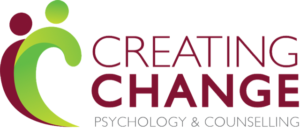Ensuring our clients are cared for and protected is a priority at Creating Change. We fortunately interrupted a recent client delayed for their appointment, mid call with a scammer. We ensured the call ended and proceeded to educate the client on our procedures and steps we take.
This experience raised our awareness of our clients at risk. Often scammers will target those that are deemed ‘high risk’ – those anxious or unsure, the elderly, or even those with intellectual disabilities. They have no boundaries when it comes to targeting individuals.

Warning Sign to Look Out For
A significant warning sign is being contacted out of the blue, someone asking you to ‘help’, especially a contact from another country. The way of asking can involve some type of conflict or issue being told, involving money being transferred in or out of your account. There may be an offering of a financial reward involved too, which can either include a share in the amount for assisting them in accessing their “trapped” funds, depending on what the situation may be.
For remote access scams the warning signs are quite similar. The caller may request remote access to your computer claiming to find the “problem”, as well as convincing you to buy unnecessary software or services. Like many scams, the scammer will ask you for your personal details and bank account or credit card details. A big warning sign to look out for is the caller being quite persistent, or even abusive.
How to Protect Yourself from Scammers
- Never send money, or give credit card details, online account details or copies of personal documents to anyone you don’t know or trust
- Avoid transferring money for, or to someone else you don’t know
- If you have any doubts, seek independent advice from someone you know and trust
- Avoid sending payments via platforms that make it difficult to recover such as; money orders, wire transfer, international funds transfers, pre-loaded cards, or electronic currency (Bitcoin).
- It’s important to verify the identity of the contact (if they are claiming to be from an organisation). This can be done by calling the business directly, and locating their contact number through a phone book or online search.
- Search the internet using the names and contact details of the letter, email or phone call you have received, in order to check for any references of a scam.
It’s important to stay vigilant these days, as scammers can be anywhere. At Creating Change we protect your privacy, and support clients to live their best life. We are aware of such scams and ensure we educate our clients on ways to protect yourself from scammers.
Below are a list of helpful scammer resources we have put together. The Scam Watch and ACCC websites contain a range of tools and resources about scams.
Scam watch Report Form – to report any scams you have come across to
Helping a friend or family member who is a victim to a scam – useful information if someone close to you has been scammed
Be Safe, Be Alert Online – organisations which can help individuals who have been scammed
Little Black Book of Scams – additional information on how to identify a scam
A guide to help older people avoid abuse, scams and fraud. – additional information on how elderly people can identify and protect themselves from scams
NDIS – calling the NDIS Fraud Reporting and Scams Helpline on 1800 650 717 or email fraudreporting@ndis.gov.au

